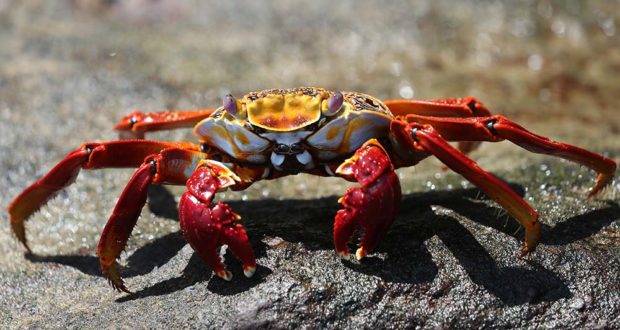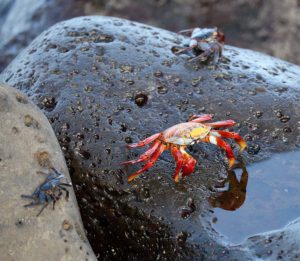When young, they are a mottled black and dark green and scurry unobtrusively among the algae-strewn rocks. With each molt, they become more colorful, losing their youthful camouflage. To avoid predators they then must rely on their swiftness and ability to hunker down into rock crevices.
Unlike most Galapagos fauna, they flee when approached, scampering quickly on the tips of their legs and jumping from rock to rock, sometimes squirting a stream of water in the direction of their adversary. The story goes that they got their name many years ago from sailors who told of a night club dancer in the Caribbean – Sally Lightfoot – who was known for her bright red and orange dress and the light, swift movements of her dance.Sally Lightfoot crabs feed mostly on red and green algae attached to rocks, using their claws as utensils, quickly tearing off small morsels and passing them to their mouth. Even so, they are scavengers and will eat just about anything, including detritus, small fish, sponges and other crustaceans.
Because they breathe through gills they don’t stray far from the waves that wash over the rocks, and they are remarkably able to stand their ground amid the churning white foam. When a wave approaches, they quickly grip the rocks and flatten themselves against the current, similar to a bather ducking under an oncoming wave.
The Encyclopedia of Life describes their mating ritual:
During courtship, males will battle for females by first facing each other then side stepping right and left in tandem while touching claws. If neither crab retreats, one crab will lunge at the other and try to grab his rival’s claws and break them off; if this occurs, the retreating crab is chased away by the victor, who now has access to a nearby female.
Mating is relatively brief – at least the one I saw. The male and female faced each other, embraced and then went their own ways. Apparently that is the extent of the male’s contribution.
Sally Lightfoot Crabs are native to the Galapagos but widely distributed throughout the coasts of North and South America. It turns out Darwin not only saw but collected specimens of the crab, but he did so earlier in his voyage when he visited Valparaiso, Chile, in August 1834, as detailed in his zoological notes:
Graspus, with pincers coloured “purplish red” & Plagusia (+ Dic. Class.) with pincers white: tail, lower joint of pieds machoires & base of joints in legs, coloured dark “peach blossom red”. both these live in numbers under stones at Rat Island where the water is only brackish.
By the time he got to Galapagos, they probably weren’t worth noting further, considering everything else spread out before him.

